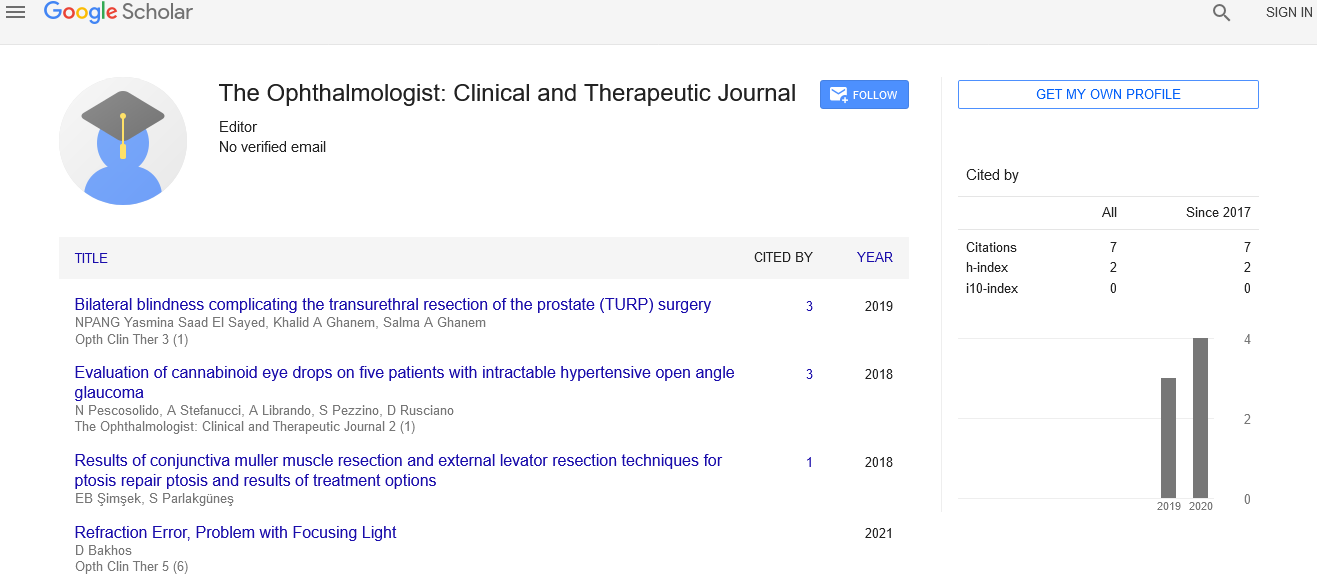Therapeutic progression of ophthalmology
Received: 27-Oct-2020 Accepted Date: Nov 12, 2020; Published: 20-Nov-2020
Citation: Morrison D. Therapeutic progression of ophthalmology. Opth Clin Ther. 2020;4(3):12.
This open-access article is distributed under the terms of the Creative Commons Attribution Non-Commercial License (CC BY-NC) (http://creativecommons.org/licenses/by-nc/4.0/), which permits reuse, distribution and reproduction of the article, provided that the original work is properly cited and the reuse is restricted to noncommercial purposes. For commercial reuse, contact reprints@pulsus.com
Introduction
On behalf of “The Ophthalmologist: Clinical and Therapeutic Journal” I am gratified to present the Volume 3 Issue 3 of the journal. Our Journal was organized in 2017 releasing issues every year. It has been made possible because of the utmost support given by our authors, readers and most importantly by the editorial board members [1].
Our journal is an open access and a peer reviewed journal which reflects all types of articles related to ophthalmology. Our articles include review, research, case reports, short communication, mini-review etc. The Journal follows double blind peer review process in which the details of authors are not revealed to each other. It is also indexed in Google scholar and also in many other reputed databases.
The journal homepage itself gives a clear idea about the scope of the journal. Authors can easily find out the process of submission of articles in the menu bar by clicking the instructions for author content. The journal also has a good response in social media such as Twitter, LinkedIn and Facebook. Authors can communicate with us through social media and can get a clear idea about the journal.
Scope of the journal
“The Ophthalmologist: Clinical and Therapeutic Journal” mainly focusses on the topics such as ophthalmology, diseases of eye and eye orbit, anatomy and physiology of eye, cornea, glaucoma, medical retina, neuro-ophthalmology, ocular oncology, oculoplastics, retinal ophthalmology, anterior segment cataracts, eye diseases, vision rehabilitation, ophthalmoscope, optics, ciliary body, tear ducts, cataract surgery, couching, ophthalmic pathology, pediatric ophthalmology, refractive surgery, vitreo-retinal surgery, eye color etc [2].
Ophthalmology
Over the ages, the understanding of anatomy and physiology of the eye has been developed a lot and various major breakthroughs took place. Ophthalmology is a branch of surgery and medicine which deals with the treatment and diagnosis of eye disorders and diseases. A specialist in ophthalmology is called as ophthalmologist. They diagnose and treat various eye problems by including surgery and therapy. The examination of eye is also a necessary task for ophthalmologists. To become an ophthalmologist, one should complete their 4 year graduation and 1 year post graduation. Also they must undergo training of a year or two with specialization on different fields of ophthalmology such as cornea, retina, pediatrics, refractive surgery, glaucoma, uveitis, neuro-ophthalmology and ocular oncology [3].
Eye disorders and diseases include glaucoma, uveitis, cataracts, red eyes, vision loss, double vision, dry eyes, diabetic retinopathy, proptosis, eye tumors, excessive tearing, macular degeneration, strabismus and many other eye related problems. The methods of diagnosis of eye problems include refraction, slit lamp examination, visual activity, ocular tonometry and retina examination [4].
The conditions which lead to visit an ophthalmologist include bulging eyes, excessive tearing, misaligned eyes, black specks or strings called floaters in the field of view, unexplained eye redness, loss of peripheral vision, eyelid abnormalities or problems, seeing colored circles or halos around lights, seeing flashes of light, reduced, distorted, blocked or double vision, sudden vision loss or changes, sudden or severe eye pain, eye injury, a family history of eye conditions, HIV, thyroid conditions such as Graves’ disease, high blood pressure and diabetes [5].
REFERENCES
- Iwase A, Araie M, Tomidokoro A, et al. Prevalence and causes of low vision and blindness in a Japanese adult population: the Tajimi study. Ophthalmology. 2006; 113:1354-62.
- Sheeladevi S, Seelam B, Nukella PB, et al. Prevalence of refractive errors, uncorrected refractive error, and presbyopia in adults in India: A systematic review. Indian J Ophthalmol. 2019; 67:583-92.
- Oliveira C, Ribeiro C, Franco S. Corneal imaging with slit-scanning and scheimpflug imaging techniques. Clin Exp Optom. 2011; 94:33-42.
- Buehl W, Stojanac D, Sacu S, et al. Comparison of three methods of measuring corneal thickness and anterior chamber depth. Am J Ophthalmol. 2006; 141:7-12.
- Quisling S, Sjoberg S, Zimmerman B, et al. Comparison of Pentacam and Orbscan IIz on posterior curvature topography measurements in keratoconus eyes. Ophthalmology. 2006; 113:1629-32.





